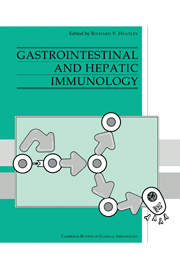Book contents
- Frontmatter
- Contents
- List of contributors
- Preface
- 1 Lymphoid cells and tissues of the gastrointestinal tract
- 2 Lymphocyte migration to the gut mucosa
- 3 Regulating factors affecting gut mucosal defence
- 4 Gastritis
- 5 The immunology of coeliac disease
- 6 Inflammatory bowel disease
- 7 Food intolerance and allergy
- 8 Gastrointestinal and liver involvement in primary immunodeficiency
- 9 Secondary immunodeficiency – the acquired immunodeficiency syndrome (AIDS)
- 10 Intestinal infections
- 11 Lymphomas
- 12 Small bowel transplantation
- 13 Clinical aspects of immunologically mediated intestinal diseases
- 14 Chronic active hepatitis
- 15 Primary biliary cirrhosis
- 16 Immunology and immunopathology of acute viral hepatitis
- 17 Immunology of liver transplantation
- 18 Clinical correlates with hepatic diseases
- Index
9 - Secondary immunodeficiency – the acquired immunodeficiency syndrome (AIDS)
Published online by Cambridge University Press: 03 February 2010
- Frontmatter
- Contents
- List of contributors
- Preface
- 1 Lymphoid cells and tissues of the gastrointestinal tract
- 2 Lymphocyte migration to the gut mucosa
- 3 Regulating factors affecting gut mucosal defence
- 4 Gastritis
- 5 The immunology of coeliac disease
- 6 Inflammatory bowel disease
- 7 Food intolerance and allergy
- 8 Gastrointestinal and liver involvement in primary immunodeficiency
- 9 Secondary immunodeficiency – the acquired immunodeficiency syndrome (AIDS)
- 10 Intestinal infections
- 11 Lymphomas
- 12 Small bowel transplantation
- 13 Clinical aspects of immunologically mediated intestinal diseases
- 14 Chronic active hepatitis
- 15 Primary biliary cirrhosis
- 16 Immunology and immunopathology of acute viral hepatitis
- 17 Immunology of liver transplantation
- 18 Clinical correlates with hepatic diseases
- Index
Summary
Introduction
Much of the current knowledge of the features of secondary immunodeficiency has been learnt from patients with HIV infection and AIDS. This is a reflection of both the scale of this epidemic and the progressive and severe nature of the immune destruction. The result is that HIV infection has become the most common significant immunodeficiency that clinicians are likely to encounter. The gastrointestinal tract is intimately involved in the host–HIV relationship; not only is it a major site of presentation of secondary opportunist infections and tumours, but it is also a primary target for HIV through direct infection of the gastrointestinal and immunological cells within the tract. In addition, the gut is the site of viral entry in acute HIV infection occurring through anal intercourse and vaccine programmes aimed at stimulating mucosal immunity are now viewed as a major goal. This chapter will discuss the immunopathogenic mechanisms of HIV infection, with specific reference to the interactions with the gastrointestinal tract. The concepts of host-pathogen relationships that have been developed are applicable to the many other secondary immunodeficiency states (Table 9.1).
The human immunodeficiency virus (HIV) and AIDS–an overview
It is estimated that 14 million people worldwide are currently HIV infected, and there were 2.5 million documented AIDS cases in early 1993 (WHO 1993). In every country where cases are documented (developed or developing), the annual incidence continues to rise. AIDS affects mainly young people, the virus being transmitted efficiently by sexual intercourse, transplacentally and through the sharing of equipment used for injecting drugs.
- Type
- Chapter
- Information
- Gastrointestinal and Hepatic Immunology , pp. 178 - 203Publisher: Cambridge University PressPrint publication year: 1994



